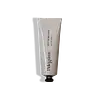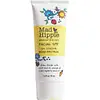What's inside
What's inside
 Key Ingredients
Key Ingredients

 Benefits
Benefits

 Concerns
Concerns

 Ingredients Side-by-side
Ingredients Side-by-side

Water
Skin ConditioningJojoba Oil/Caprylic/Capric Triglyceride Esters
Skin ConditioningVitis Vinifera Seed Oil
EmollientVitis Vinifera Vine Extract
Skin ConditioningRubus Idaeus Seed Oil
EmollientGlyceryl Stearates
EmollientGlyceryl Stearate
EmollientPEG-100 Stearate
Glycerin
HumectantCetyl Alcohol
EmollientStearic Acid
CleansingLavandula Officinalis Flower Oil
PerfumingMentha Citrata Oil
Cananga Odorata Flower Oil
MaskingParfum
MaskingZinc Oxide
Cosmetic ColorantTitanium Dioxide
Cosmetic ColorantMethyl Anthranilate
MaskingEthylhexyl Salicylate
UV AbsorberCitrus Sinensis Peel Oil Expressed
PerfumingTocopheryl Acetate
AntioxidantPhenoxyethanol
PreservativeEthylhexylglycerin
Skin ConditioningCitral
PerfumingLimonene
PerfumingGeraniol
PerfumingCitronellol
PerfumingFarnesol
PerfumingIsoeugenol
PerfumingWater, Jojoba Oil/Caprylic/Capric Triglyceride Esters, Vitis Vinifera Seed Oil, Vitis Vinifera Vine Extract, Rubus Idaeus Seed Oil, Glyceryl Stearates, Glyceryl Stearate, PEG-100 Stearate, Glycerin, Cetyl Alcohol, Stearic Acid, Lavandula Officinalis Flower Oil, Mentha Citrata Oil, Cananga Odorata Flower Oil, Parfum, Zinc Oxide, Titanium Dioxide, Methyl Anthranilate, Ethylhexyl Salicylate, Citrus Sinensis Peel Oil Expressed, Tocopheryl Acetate, Phenoxyethanol, Ethylhexylglycerin, Citral, Limonene, Geraniol, Citronellol, Farnesol, Isoeugenol
Zinc Oxide 16%
Cosmetic ColorantAloe Barbadensis Leaf Juice
Skin ConditioningPersea Gratissima Fruit Butter
EmollientWater
Skin ConditioningCaprylic/Capric Triglyceride
MaskingCaprylyl Glycol
EmollientCetyl Alcohol
EmollientCitrus Sinensis Peel Oil Expressed
PerfumingDaucus Carota Sativa Seed Oil
EmollientEthylhexylglycerin
Skin ConditioningGlycerin
HumectantIsostearic Acid
CleansingJasminum Officinale Oil
MaskingPersea Gratissima Oil
Skin ConditioningPhenethyl Alcohol
MaskingPolyglyceryl-3 Beeswax
EmulsifyingPolyglyceryl-6 Distearate
EmulsifyingRubus Idaeus Seed Oil
EmollientSimmondsia Chinensis Seed Oil
EmollientSodium Ascorbyl Phosphate
AntioxidantSodium Hyaluronate
HumectantPPG-5 Tocopheryl Ether
AntioxidantZinc Oxide 16%, Aloe Barbadensis Leaf Juice, Persea Gratissima Fruit Butter, Water, Caprylic/Capric Triglyceride, Caprylyl Glycol, Cetyl Alcohol, Citrus Sinensis Peel Oil Expressed, Daucus Carota Sativa Seed Oil, Ethylhexylglycerin, Glycerin, Isostearic Acid, Jasminum Officinale Oil, Persea Gratissima Oil, Phenethyl Alcohol, Polyglyceryl-3 Beeswax, Polyglyceryl-6 Distearate, Rubus Idaeus Seed Oil, Simmondsia Chinensis Seed Oil, Sodium Ascorbyl Phosphate, Sodium Hyaluronate, PPG-5 Tocopheryl Ether
Ingredients Explained
These ingredients are found in both products.
Ingredients higher up in an ingredient list are typically present in a larger amount.
Cetyl Alcohol is a fatty alcohol. Fatty Alcohols are most often used as an emollient or to thicken a product.
Its main roles are:
Though it has "alcohol" in the name, it is not related to denatured alcohol or ethyl alcohol.
The FDA allows products labeled "alcohol-free" to have fatty alcohols.
Learn more about Cetyl AlcoholSweet orange peel oil is created by cold-pressing the sweet orange's peel until the oil is released.
This ingredient is generally safe but may result in phototoxicity or dermatitis in higher concentrations due to citrus' furocoumarins content.
Furocoumarins are phototoxic when exposed to UV.
Learn more about Citrus Sinensis Peel Oil ExpressedEthylhexylglycerin (we can't pronounce this either) is commonly used as a preservative and skin softener. It is derived from glyceryl.
You might see Ethylhexylglycerin often paired with other preservatives such as phenoxyethanol. Ethylhexylglycerin has been found to increase the effectiveness of these other preservatives.
Glycerin is already naturally found in your skin. It helps moisturize and protect your skin.
A study from 2016 found glycerin to be more effective as a humectant than AHAs and hyaluronic acid.
As a humectant, it helps the skin stay hydrated by pulling moisture to your skin. The low molecular weight of glycerin allows it to pull moisture into the deeper layers of your skin.
Hydrated skin improves your skin barrier; Your skin barrier helps protect against irritants and bacteria.
Glycerin has also been found to have antimicrobial and antiviral properties. Due to these properties, glycerin is often used in wound and burn treatments.
In cosmetics, glycerin is usually derived from plants such as soybean or palm. However, it can also be sourced from animals, such as tallow or animal fat.
This ingredient is organic, colorless, odorless, and non-toxic.
Glycerin is the name for this ingredient in American English. British English uses Glycerol/Glycerine.
Learn more about GlycerinRubus Idaeus Seed Oil is created from the seeds of the raspberry fruit. Raspberries are native to northern Europe and Asia.
Raspberry seed oil is an emollient with antioxidant and anti-inflammatory properties. It is rich in fatty acids, tocopherols, flavonoids, Vitamin C, and Vitamin E.
As an emollient, raspberry seed oil helps hydrate your skin. Emollients prevent moisture from evaporating by creating a film on top.
Learn more about Rubus Idaeus Seed OilWater. It's the most common cosmetic ingredient of all. You'll usually see it at the top of ingredient lists, meaning that it makes up the largest part of the product.
So why is it so popular? Water most often acts as a solvent - this means that it helps dissolve other ingredients into the formulation.
You'll also recognize water as that liquid we all need to stay alive. If you see this, drink a glass of water. Stay hydrated!
Learn more about WaterZinc Oxide is a mineral broad-spectrum UV filter; it is the broadest UVA and UVB reflector approved by the FDA. It also has skin protectant and skin soothing properties.
Zinc oxide is one of the most effective broad-spectrum UV filters. It protects against UVB, UVAII, and UVAI. In comparison to its counterpart titanium dioxide, zinc oxide provides uniform and extended UVA protection.
Another great benefit? This ingredient is highly photostable so it won't degrade easily under sunlight.
A common myth is that mineral UV filters are widely believed to primarily reflect UV light.
However, modern research shows titanium dioxide absorbs UV radiation like chemical filters (~95% absorption & 5% reflection).
Zinc oxide has great skin soothing properties so you'll likely find this in sunscreens formulated for sensitive skin or babies/children. It is unlikely to cause "eye sting" like other sunscreen ingredients.
Regulatory agencies consider zinc oxide to be non-toxic and safe. It has also been shown to not penetrate the skin.
Unfortunately, this ingredient does leave a visible white cast. This is why mineral sunscreens are often less cosmetically elegant than chemical or hybrid ones.
In cosmetics, zinc oxide can be found in both non-nano and nano-sized forms. The nano version is used to reduce white cast and improve the texture of sunscreen formulas.
There are ongoing concerns surrounding nano-zinc oxide's impact on marine ecosystems and whether it can be absorbed into skin.
Regarding marine ecosystems and coral reefs, there is no conclusive evidence that any form of zinc oxide (or any other sunscreen ingredients) will cause harm. The science is still developing but many consumers are keeping a close eye on this issue.
Please note, many destinations have reef-safety sunscreen rules. For instance, the U.S. Virgin Islands advises all visitors to use non-nano mineral sunscreens.
There has also been some stir about whether micronized or nano zinc oxide has potential photoxicity and absorption through the skin/lungs.
An in-vitro (done in a test tube or petri dish) study demonstrated micronized zinc oxide to have potential phototoxicity. There's no need to fret; the EU Commission's Scientific Committee on Consumer Safety has stated, "The relevance of these findings needs to be clarified by appropriate investigations in vivo." Or in other words, further studies done on living organisms are needed to prove this.
Current research shows zinc oxide nanoparticles do not penetrate intact or sunburned skin. They either remain on the surface or in the outermost layer of dead skin (stratum corneum).
Zinc oxide is one of only two classified mineral UV filters with titanium dioxide being the other one.
Fun fact: Zinc has been used throughout history as an ingredient in paint and medicine. An Indian text from 500BC is believed to list zinc oxide as a salve for open wound. The Ancient Greek physician Dioscorides has also mentioned the use of zinc as an ointment in 1AD.
Learn more about Zinc Oxide